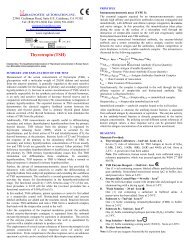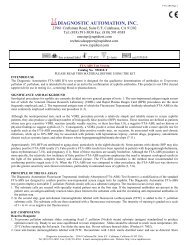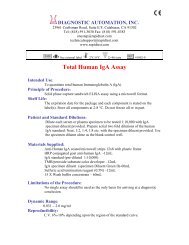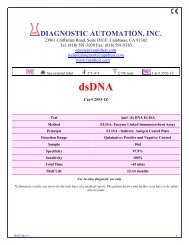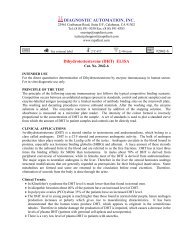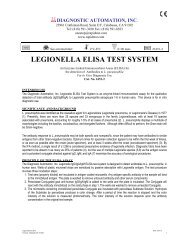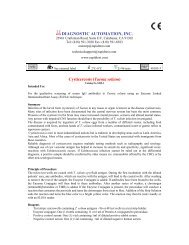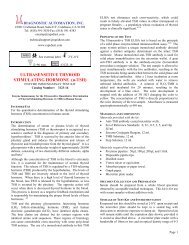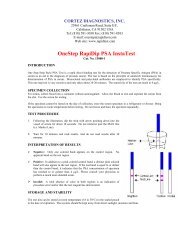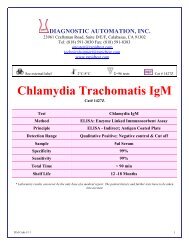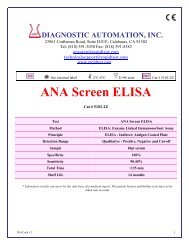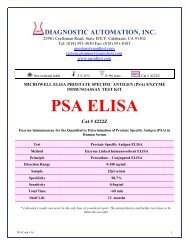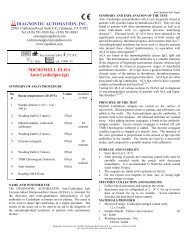Serum IgE 15150 - Diagnostic Automation : Cortez Diagnostics
Serum IgE 15150 - Diagnostic Automation : Cortez Diagnostics
Serum IgE 15150 - Diagnostic Automation : Cortez Diagnostics
You also want an ePaper? Increase the reach of your titles
YUMPU automatically turns print PDFs into web optimized ePapers that Google loves.
CORTEZ DIAGNOSTICS, INC.<br />
23961 Craftsman Road, Suite E/F,<br />
Calabasas, CA 91302 USA<br />
Tel: (818) 591-3030 Fax: (818) 591-8383<br />
E-mail: onestep@rapidtest.com<br />
Web site: www.rapidtest.com<br />
See external label<br />
2°C-30°C<br />
Σ=25 or 50 tests Cat. #<strong>15150</strong>-1<br />
<strong>IgE</strong> <strong>Serum</strong> Test<br />
<strong>IgE</strong> Test Kit<br />
Cat. No. <strong>15150</strong>-1<br />
Summary<br />
Allergic or immediate hypersensitivity reactions are known as Type I immunopathologic reactions that may occur within minutes of an allergic challenge.<br />
In 1967 Ishizaka identified the serum factor capable of mediating allergic reactivity as Immunoglobulin E (<strong>IgE</strong>). The Fc portion of this reaginic antibody<br />
attaches to Fc receptors on the surface of target cells, tissue mast cells, and circulating basophils leaving the F (ab) portion of the molecule available to<br />
bind with its homologous antigen. Upon contact with a specific allergen, the <strong>IgE</strong> mediates cell release of pharmacologic substances such as histamine,<br />
prostaglandins, and leukotrienes that result in allergic reactions ranging from hay fever, urticaria (hives), and bronchial asthma, to generalized<br />
anaphylactic shock.<br />
The discovery of the role of <strong>IgE</strong> in clinical allergy resulted in a new generation on in-vitro diagnostic assays to test for allergen sensitivity. The first<br />
immunoassays were developed to quantitative the serum concentration of total <strong>IgE</strong>. In normal individuals, <strong>IgE</strong> is usually present at low levels where 130<br />
ng/mL represents the upper limit of the normal range. However, a significant number of asymptomatic normal individuals, patients with parasitic<br />
diseases and patients with depressed cell-mediated immunity exceed this level. Also, some allergic (atopic) persons may exhibit normal total <strong>IgE</strong> test<br />
results in the presence of elevated levels of specific <strong>IgE</strong>. Therefore, although the total serum <strong>IgE</strong> level is considered useful in the evaluation of an allergic<br />
patient, more important is the demonstration of allergen-specific <strong>IgE</strong> in patients’ serum. RAST was developed for this purpose.<br />
An elevated concentration of Immunoglobulin E (<strong>IgE</strong>) in serum is a common symptom associated with allergic pathologies. Autoimmune diseases and<br />
some infections may cause the elevation of <strong>IgE</strong>. The One Step <strong>IgE</strong> test can detect elevated levels of <strong>IgE</strong> rapidly.<br />
The One Step <strong>IgE</strong> test is a highly sensitive immunoassay for qualitative determination of human <strong>IgE</strong> in plasma or serum. This test is intended for<br />
professional use as an aid in the diagnosis and treatment of <strong>IgE</strong>-mediated allergic and autoimmune disorders. One Step <strong>IgE</strong> test can detect elevated levels<br />
or <strong>IgE</strong> in 5 minutes or less. The sensitivity of the test is 80 IU/ml.<br />
<strong>IgE</strong> test cassette has a letter of T and C as “Test Line” and “Control” on the surface of the case. Both the “Test Line” and “Control Line” in result<br />
window are not visible before applying any samples. The “Control Line” is used for procedural control. Control line should always appear if the test<br />
procedure is performed properly and the test reagents of control line are working. When the specimen flows through a absorbing pad containing purified<br />
<strong>IgE</strong> antibody coupled to purple beads. If the sample contains <strong>IgE</strong> specific IgG antilbody, the antibody will bind to the antigen coupled to the red beads<br />
which, in turn, will bind to a monoclonal anti-human IgG antibody spotted on the membrane in the form of a line. As the <strong>IgE</strong> antigen-antibody complex is<br />
captured, a purple Test Line will be visible in the Result Window. If <strong>IgE</strong>-specific IgG antibody is not present or is present at very low levels in the patient<br />
sample, there is no color appears in Test Line.<br />
Table of Contents<br />
Executive Summary<br />
A. Background Information<br />
B. Summary of Safety and Effectiveness Studies<br />
1. Name of Product<br />
2. Indication<br />
3. Standard Substance<br />
4. Component Composition<br />
5. Production Process<br />
6. Analytical Sensitivity<br />
7. Specificity<br />
8. Reproducibility and Stability<br />
9. Comparison Studies<br />
10. Near Patient Test Results<br />
C. Quality Control Procedure<br />
1. Trial Site<br />
2. Trial Protocols<br />
D. Bibliography<br />
E. Labeling Material<br />
A. Background<br />
Allergic or immediate hypersensitivity reactions are known as Type I immunopathologic reactions that may occur within minutes of an allergic challenge.<br />
In 1967 Ishizaka identified the serum factor capable of mediating allergic reactivity as Immunoglobulin E (<strong>IgE</strong>). The Fc portion of this reaginic antibody<br />
attaches to Fc receptors on the surface of target cells, tissue mast cells, and circulating basophils leaving the F(ab) portion of the molecule available to<br />
bind with its homologous antigen. Upon contact with a specific allergen, the <strong>IgE</strong> mediates cell release of pharmacologic substances such as histamine,<br />
prostaglandins, and leukotrienes that result in allergic reactions ranging from hay fever, urticaria (hives), and bronchial asthma, to generalized<br />
anaphylactic shock.<br />
The discovery of the role of <strong>IgE</strong> in clinical allergy resulted in a new generation on in-vitro diagnostic assays to test for allergen sensitivity. The first<br />
immunoassays were developed to quantitate the serum concentration of total <strong>IgE</strong>. In normal individuals, <strong>IgE</strong> is usually present at low levels where 130
ng/mL represents the upper limit of the normal range. However, a significant number of asymptomatic normal individuals, patients with parasitic<br />
diseases and patients with depressed cell-mediated immunity exceed this level. Also, some allergic (atopic) persons may exhibit normal total <strong>IgE</strong> test<br />
results in the presence of elevated levels of specific <strong>IgE</strong>. Therefore, although the total serum <strong>IgE</strong> level is considered useful in the evaluation of an allergic<br />
patient, more important is the demonstration of allergen-specific <strong>IgE</strong> in patients’ serum. RAST was developed for this purpose.<br />
Historically, the diagnosis of allergic disease has been based primarily on two types of in-vivo testing; i.e., provocation (challenge testing) and skin<br />
testing. The use of provocation testing involves double-blind challenge that duplicates natural exposure. Responses to challenge other than by natural<br />
exposure are dependent on physical characteristics of test material as well as on the dose and duration of exposure to it. Skin testing, either intradermal or<br />
prick/puncture (epicutaneous) is a frequently used clinical method of diagnosing allergy. Although these tests do produce false results in some instances,<br />
for certain allergens they exhibit greater clinical sensitivity than RAST. However, other recognized clinical modalities may also be used to assess the<br />
clinical status of patients. These include nasal or bronchial challenge tests for diagnosing inhalant allergies, and oral challenge testing for diagnosis of<br />
food allergies. In-vitro allergen-specific <strong>IgE</strong> testing is especially useful when skin testing cannot be performed or interpreted at patients with generalized<br />
dermatitis, or in those who must continue to take antihistamine medications. In-vitro testing also eliminates the risk of possible systemic reaction. It is<br />
essential that allergy test result, regardless of the procedure employed, reflect true clinical sensitivity and specificity in order to prevent mismanagement<br />
of patients.<br />
The best correlation between RAST-type tests and skin tests have been with inhalant allergins such as the pollens of trees and grasses. The FDA has<br />
noted in data received from various sponsors that concordance with skin tests varies with different allergens to less than 20% for other allergens.<br />
Therefore, FDA requests manufacturers to provide allergy specific clinical data for each new allergen they submit for their RAST-type test.<br />
Atopic status of patients may also be defined by physical examination and clinical history and should be included as part of the comparison data. Since<br />
January 1990, manufacturers have been required to state in their package inserts the concordance for each allergen between the RAST-type test and the<br />
comparative clinical test if the concordance is below 65-70 percent.<br />
In order to alert RAST users to an important potential cause of false negative results for food allergies, the following statement should be incorporated<br />
into the Limitations section of package inserts:<br />
“When testing for food allergies, circulating <strong>IgE</strong> antibodies may not be detected if they are directed towards altered forms of allergens (such as cooked,<br />
processed or digested) and the altered forms are not present in the same form as those food allergens which are used in the test.”<br />
Two other tests for food allergies that are the subjects of scientific concern are cytotoxicity testing, and the measurement of serum levels of IgG and IgG4<br />
antibodies to specific food allergens. Clinical data for these two tests are not conclusive for diagnosis of food allergies and FDA does not recognize these<br />
tests to be safe and effective.<br />
The first preamendment (prior to May 28, 1976) test kit intended for measurement of circulating allergen specific <strong>IgE</strong> in blood specimens used a paper<br />
radioimmunosorbent disc (PRIST) which was the forerunner of the current RAST and RAST-type systems. The original RAST methodology was<br />
radioimmunoassay. Later modifications included enzymeimmunoassay, luminescence immunoassay and fluorescence immunoassay in fluid phases, as<br />
well as a variety of solid phases including dipsticks. Methodologies used to assay Total <strong>IgE</strong> include radioimmunoassay, enzymeimmunoassay, and laser<br />
nephelometry.<br />
In the time span from 1977 to 1981 a total of five 510(k) notifications were submitted by device manufacturers for review. From 1986 to 1992, the total<br />
number of RAST submissions received by FDA increased to 167. This increase represents expansion of the numbers of allergens proposed for use with<br />
original test systems, modification of existed test kits such as the use of monoclonal antibody reagents, and additional companies manufacturing these<br />
tests.<br />
The One step <strong>IgE</strong> test is a highly sensitive immunoassay for qualitative determination of human <strong>IgE</strong> in plasma or serum. This test is intended for<br />
professional use as an aid in the diagnosis and treatment of <strong>IgE</strong>-mediated allergic and autoimmune disorders. One Step <strong>IgE</strong> test can detect elevated levels<br />
or <strong>IgE</strong> in 5 minutes or less. The sensitivity of the test is 80 IU/ml.<br />
<strong>IgE</strong> test cassette has a letter of T and C as “Test Line” and “Control” on the surface of the case. Both the “Test Line” and “Control Line” in result<br />
window are not visible before applying any samples (Fig. 1). The “Control Line” is used for procedural control. Control line should always appear if the<br />
test procedure is performed properly and the test reagents of control line are working (Fig. 2). When the specimen flows through a absorbing pad<br />
containing purified <strong>IgE</strong> antibody coupled to purple beads. If the sample contains <strong>IgE</strong> specific IgG antilbody, the antibody will bind to the antigen coupled<br />
to the red beads which, in turn, will bind to a monoclonal anti-human IgG antibody spotted on the membrane in the form of a line. As the <strong>IgE</strong> antigenantibody<br />
complex is captured, a purple Test Line will be visible in the Result Window (Fig. 3). If <strong>IgE</strong>-specific IgG antibody is not present or is present at<br />
very low levels in the patient sample, there is no color appears in Test Line.<br />
Fig.1<br />
Fig. 2 Fig. 3<br />
<strong>Cortez</strong> <strong>Diagnostic</strong>s <strong>IgE</strong> test kit contains following items to perform the assay; <strong>Cortez</strong> <strong>Diagnostic</strong>s <strong>IgE</strong> test device, disposable sample dropper and<br />
instructions for use. However, the test kit do not contains specimen collection container and clock or timer. The test kit should be stored at room<br />
temperature. The expiration date was determined under normal laboratory conditions.<br />
B. Summary of Safety and Effectiveness Studies<br />
1. Name of Product:<br />
One Step Antigen of the Immunoglobuline E (Ig E)Test.<br />
2. Indication:<br />
The One Step Ig E test is designed for the qualitative determination of human surface antigen of the immunoglobuline E in serum.<br />
3. Standard Substance:<br />
Antibody to Antigen.of the Ig E.<br />
4. Component Composition:<br />
Each test unit contains:<br />
Major Ingredients<br />
Quantity/Test<br />
Goat Anti-(Mouse IgG) Polyclonal Antibody<br />
62 ug/test<br />
Goat anti-Ig E antibody<br />
44 ug/test<br />
anti-Ig E antibody-Colloidal Gold Conjugate<br />
34 ug/test
5. Production Process:<br />
a). Nitrocellulose membrane is coated with a Goat Anti – (Mouse IgG) Polyclonal Antibody solution is the Control Reaction Zone, and coated with anti-<br />
Ig E antibody conjugate solution in the Test Reaction Zone. The coated membrane is dried overnight, blocked with a PBS/Triton X-100 buffer for 5<br />
minutes, and then dried overnight again.<br />
b). A buffered solution of anti-Ig E. antibody–Colloidal Gold Conjugate is sprayed on fiberglass and then lyophilized in a 48-hour cycle.<br />
c). The blocked and dried membrane is then applied to an adhesive-backed vinyl strip. An absorbent material is applied to the vinyl strip so that it is in<br />
contact with the membrane close to the Control Reaction Zone. The lyophilized conjugate – coated fiberglass is applied to the vinyl strip so that it is in<br />
contact with the membrane close to the Test Reaction Zone. The completed strips are then die-cut at a 7 mm width or 5 mm.<br />
d). The die-cut strips are assembled in plastic housings and sealed in moisture-proof foil pouches along with a desiccant packet and a disposable plastic<br />
pipette.<br />
6. Analytical Sensitivity:<br />
An in-house study was conducted with three separate lots of the One Step Ig E.<strong>Serum</strong> Test to determine the analytical sensitivity of the test. Each lot was<br />
tested three times at each control level, with the comparison results shown in the following table.<br />
Table I: Analytical sensitivity testing.<br />
Test Lot # of times Antibody To Ig E. Conc.,IU/ml<br />
0 20 40 80 160 320<br />
1 (-) (-) (-) (+) (+) (+)<br />
A 2 (-) (-) (-) (+) (+) (+)<br />
3 (-) (-) (-) (+) (+) (+)<br />
1 (-) (-) (-) (+) (+) (+)<br />
B 2 (-) (-) (-) (+) (+) (+)<br />
3 (-) (-) (-) (+) (+) (+)<br />
1 (-) (-) (-) (+) (+) (+)<br />
C 2 (-) (-) (-) (+) (+) (+)<br />
3 (-) (-) (-) (+) (+) (+)<br />
7. Specificity:<br />
An in-house study is conducted with 3 separated lots of the One Step Ig E <strong>Serum</strong> Test to determine the Specificity of One Step Ig E. test.<br />
<strong>Serum</strong> with trygliceride concentration up to 500 mg/ml,<br />
<strong>Serum</strong> with Dilirbin concentration up to 10 mg/100ml,<br />
Hemolized specimens with hemoglobin concentration up to 10 mg/ml<br />
Prostatic acid phosphatase with concentration up to 1000 ng/ml<br />
albumin with concentration up to 20 mg/ml.<br />
All of the above were analyzed and did not show interference or cross reactivity with the test.<br />
8. Reproducibility & Stability:<br />
Method<br />
Reproducibility and stability studies were carried out on three different lots of the One Step Ig E. <strong>Serum</strong> Test. The lots, upon approval (t=0) were stored<br />
at 15 – 38 degrees C, and tested over an eighteen month time period from date of manufacture. In-house controls were tested according to the<br />
Instructions for use with the three lots at regular intervals (0,3,6,9,12,15, and 18 months from date of approval).<br />
Acceptance Criteria<br />
Each stability test is passed if:<br />
a. The test gave a negative result when tested with a Ig E-negative serum sample.<br />
b. The test gave a positive result when tested with a 80 IU/ml Ig E-positive serum sample.<br />
Results are shown in the following table.<br />
Table II: Stability testing.<br />
Month Number Ig E. negative sample Ig E. positive sample<br />
Lot A Lot B Lot C Lot A Lot B Lot C<br />
1 (-) (-) (-) (+) (+) (+)<br />
0 2 (-) (-) (-) (+) (+) (+)<br />
3 (-) (-) (-) (+) (+) (+)<br />
1 (-) (-) (-) (+) (+) (+)<br />
3 2 (-) (-) (-) (+) (+) (+)<br />
3 (-) (-) (-) (+) (+) (+)<br />
1 (-) (-) (-) (+) (+) (+)<br />
6 2 (-) (-) (-) (+) (+) (+)<br />
3 (-) (-) (-) (+) (+) (+)<br />
1 (-) (-) (-) (+) (+) (+)<br />
9 2 (-) (-) (-) (+) (+) (+)<br />
3 (-) (-) (-) (+) (+) (+)<br />
1 (-) (-) (-) (+) (+) (+)<br />
12 2 (-) (-) (-) (+) (+) (+)<br />
3 (-) (-) (-) (+) (+) (+)<br />
1 (-) (-) (-) (+) (+) (+)
15 2 (-) (-) (-) (+) (+) (+)<br />
3 (-) (-) (-) (+) (+) (+)<br />
1 (-) (-) (-) (+) (+) (+)<br />
18 2 (-) (-) (-) (+) (+) (+)<br />
3 (-) (-) (-) (+) (+) (+)<br />
Comparison Study:<br />
(1) Clinical Symptoms Criteria:<br />
The bronchial asthma is only allergic disorder selected for this study. Bronchial asthma may be defined as episodic expiratory dyspnea associated with<br />
wheezing. Such patients are apt to show temporary relief after the administration of epinephrine. The cough in asthma is dry, tight, wheezy and usually<br />
occurs in paroxysms. Chest examination during an attach reveals the suppressed breath sounds of small airway obstruction and musical rales or rhonchi.<br />
Postmortem examination reveals extensive blocking of the finer airways with inspissated mucus plugs. Hay fever and fatigue may occur.<br />
(2) Population Tested:<br />
The population tested at three sites as following;<br />
Population tested;<br />
Table 3<br />
Population tested<br />
Site A Site B Site C<br />
Male 10 10 4<br />
Female 10 10 6<br />
Age: 70 1 0 1<br />
(3) Criteria for diagnosis:<br />
Patient suffered with episodic expiratory dyspnea associated with wheezing has been diagnosis with bronchial asthma that is only allergic disorder<br />
selected for this study.<br />
(4) Inclusion / Exclusion Criteria:<br />
If patient has above symptoms that has been release by medication and also were willing tested by laboratory <strong>IgE</strong> test and following confirmed tests were<br />
selected in study group.<br />
(5) Test procedure:<br />
An independent comparison study was performed at hospital laboratory on 50 symptomatic patients. Each specimen was tested with the One Step <strong>IgE</strong><br />
<strong>Serum</strong> Test and a commercially available test (ELISA). The results are summarized in the following tables.<br />
Ig E one step Test Positive Ig E one step Test Negative<br />
ELISA Positive (31) 30 1<br />
ELISA Negative (19) 0 19<br />
For symptomatic patients, the relative sensitivity is 96.77% (30/31), and the relative specificity is 100% (19/19).<br />
The data demonstrates that the One Step Ig E. Test is substantially equivalent to the commercially available test. The clinical significance of the two tests<br />
is comparable.<br />
Near Patient Test Result<br />
a, Clinical Specificity<br />
The clinical specificity is defined as the probability to have a negative result in the absence of the particular condition.<br />
The clinical specificity assessed by studying expected negative subjects.<br />
We classifieds negative a sample that, tested by <strong>IgE</strong> test, showed below 80 IU/ml.<br />
Sample was tested in replicates of 20 in a single run.<br />
The results are shown in the following table.<br />
Control conc. 0<br />
IU/ml<br />
number of replic Results remark<br />
20 (-)<br />
b, Clinical Sensitivity<br />
The clinical sensitivity is defined as the probability to have a positive result when the particular condition is present.<br />
The clinical sensitivity was evaluated testing samples of positive control that resulted reactive for Ig E.<br />
We classified as positive a sample that, tested by Ig E., showed a level 80 IU/ml, 160 IU/ml.<br />
The results are reported in the following table:<br />
Sample conc. number of replica results Remark<br />
80 IU/ml 10 (+)<br />
160 IU/ml 10 (+)<br />
The reproducibility is evaluated on 2 controls containing different levels of Ig E.<br />
Each sample was tested in replicates of 10 in a single run.<br />
The results are shown in the following table:<br />
Sample conc. number of replic results Remark<br />
80 IU/ml 10 (+)<br />
0 IU/ml 10 (-)
C. QUALITY CONTROL OF <strong>IgE</strong> TEST<br />
Trial site<br />
The final QC certificate is issued by <strong>Cortez</strong> <strong>Diagnostic</strong>s, Inc.<br />
Trial Protocols<br />
Different protocols were used in the performance evaluation of Ig E., as listed below.<br />
Precision<br />
intra – assay<br />
inter – lot<br />
Detection limits<br />
analytical sensitivity<br />
Precision<br />
Intra – Assay Precision<br />
The within assay precision was evaluated on 5 samples containing different levels of Ig E.<br />
Each sample was tested in replicates of 10 in single run.<br />
The results are shown in the following table:<br />
sample of Ig E. Conc. # of replic Results Remark<br />
80IUng/ml 10 (+)<br />
160IU/ml 10 (+)<br />
320IU/ml 10 (+)<br />
640IU/ml 10 (+)<br />
1000IU/ml 10 (+)<br />
Inter – lot Precision<br />
The between assay precision was evaluated on 3 samples containing different levels of Ig E.<br />
Each sample was tested in replicates of four using three different lots.<br />
The results are shown in the following table.<br />
Lot # # of test per Lot Ig E. Antibody<br />
Conc.<br />
80 IU/ml 160 IU/ml 320 IU/ml<br />
A 4 (+) (+) (+)<br />
B 4 (+) (+) (+)<br />
C 4 (+) (+) (+)<br />
Detection limits<br />
Analytical Sensitivity<br />
An in-house study was conducted with three separate lots of the One step Ig E. Test to determine the analytical sensitivity of the test. Each lot was tested<br />
five times at each control level, with the results shown in the following table:<br />
Analytical sensitivity testing<br />
Test Lot # of times Ig E. Antibody Conc. (IU/ml)<br />
0 80 160 320 640<br />
1 (-) (+) (+) (+) (+)<br />
2 (-) (+) (+) (+) (+)<br />
A 3 (-) (+) (+) (+) (+)<br />
4 (-) (+) (+) (+) (+)<br />
5 (-) (+) (+) (+) (+)<br />
B 1 (-) (+) (+) (+) (+)<br />
2 (-) (+) (+) (+) (+)<br />
3 (-) (+) (+) (+) (+)<br />
4 (-) (+) (+) (+) (+)<br />
5 (-) (+) (+) (+) (+)<br />
1 (-) (+) (+) (+) (+)<br />
2 (-) (+) (+) (+) (+)<br />
C 3 (-) (+) (+) (+) (+)<br />
4 (-) (+) (+) (+) (+)<br />
5 (-) (+) (+) (+) (+)<br />
Results:<br />
The analytical sensitivity is 80 IU/ml.<br />
C. Bibliography<br />
1, Hamilton RG and Adkinson MF, “Clinical Laboratory Methods for the Assessment and Management of Human Allergic Diseases,” Clin Lab Med,<br />
1986, 6:117-38.<br />
2, Jeske DJ and Capra JD, “Immunoglobulins: Structure and Function,” Fundamental Immunology, Paul WE, ed, New York, NY: Raven Press, 1984,<br />
131-65.<br />
3, Ownby DR, “Allergy Testing: In Vitro Versus In Vivo,” Pediatr Clin North Am, 1988, 35:995-1009.<br />
4, Van Arsdel PP Jr and Larson EB, “<strong>Diagnostic</strong> Tests for Patients With Suspected Allergic Disease,” Ann Intern Med, 1989, 110(4):304-12.<br />
5, Wall R and Kuehl M, “Biosynthesis and Regulation of Immunoglobulins,” Annu Rev Immunol, 1983, 1:393-422.
Revision Date: 12/6/06<br />
CORTEZ DIAGNOSTICS, INC.<br />
23961 Craftsman Road, Suite E/F,<br />
Calabasas, CA 91302 USA<br />
Tel: (818) 591-3030 Fax: (818) 591-8383<br />
ISO 13485-2003



